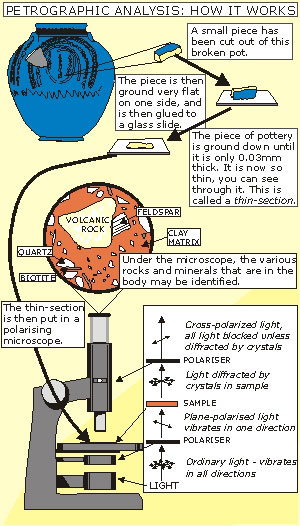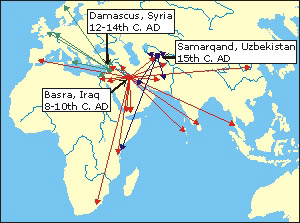Ceramic Petrography Method
Petrographic analysis: how it works
Petrographic analysis is a technique developed in the earth-sciences for observation of rocks and minerals. It involves creating a "thin-section" of the material being studied, which is a thin slice exactly 0.03 mm thick.
Once the thin-section is made it is viewed through a polarising microscope, which has two polarizing filters oriented at right-angles to each other, thereby blocking out any light (see figure). However, a sample containing minerals may diffract the light, so that they are visible in cross-polarized light. The degree of diffraction is a key characteristic enabling identification of the crystals.
The variety of minerals and rocks in the thin-section, together with their texture and range of sizes, defines the petrographically-defined fabric of the pottery, or its petrofabric. The petrofabric of a particular vessel will be diagnostic of where in the world the ceramic was made, as the geology and environment of the region around the kiln-site will dictate what appears in the pottery.
If evidence of manufacture is available from a particular site, for instance wasters (pottery ruined in the firing process, see right) or kiln-furniture (objects of clay used in the kiln, for instance spacers to separate the ceramics), it will be possible to analyse this ceramic evidence to characterize the production centre itself. So any pottery found which has the same petrofabric can be said to be from this centre, no matter how far away from that centre the pottery might have been found.
One of the most widely-traded groups of ceramics are wares made in the middle east during the Islamic period. Distributions of some of the biggest centres of production are shown in the map to the right. In all these cases samples have been shown to originate in these centres by petrographic analysis by examination of the samples themselves or by demonstrating that the types involved can only come from these centres.
Return to Ceramic Petrology Facility

Petrographic analysis: how it works

Location of important centres of ceramic production during the Islamic period
|